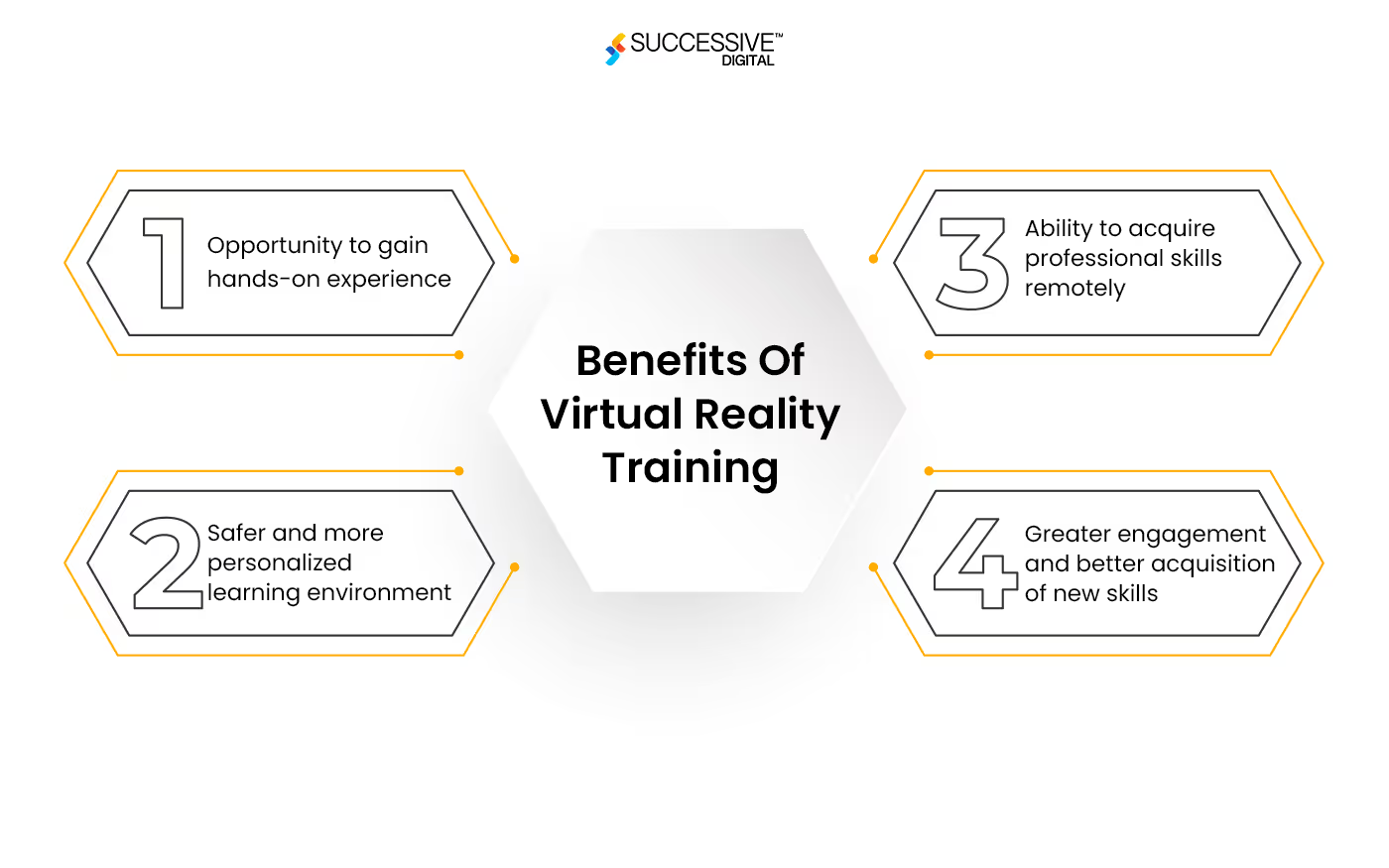Companies constantly look for advanced ways to enhance professional training and development in today's dynamic business environment. Integrating virtual reality (VR) and augmented reality (AR) into employee training programs is one such innovation that has made great impact on the overall operations. This blog explores the use of VR/AR in professional corporate education, the benefits of various aspects of immersive learning, providing in-depth, real-world examples of multiple projects, and the prospects for this modern technology in the competitive world.
Overview of VR/AR Applications in Employee Training:
Definitions and Differences Between VR and AR:
Virtual Reality immerses consumers in a computer-simulated environment, creating a more immersive experience. Conversely, augmented reality (AR) overlays digital information onto the real world, elevating the user's perception. Both technologies have equal applications in employee training.
Applications in Employee Training:
VR and AR in employee training are spreading over large areas, providing a versatile and impactful way to improve staff capacity and capability. These technologies are not just limited to specific tasks; programs are being decentralized, reshaping how companies train their employees.
Safety Training:
The use of VR in safety education has identified industries where real-world hazards may be too significant, such as manufacturing and healthcare. VR simulations create prudent scenarios, exposing workers to undoubtedly dangerous situations without actual danger. For instance, employees can access VR training modules for emergencies such as chemical spills, fires, or equipment malfunctions. This experience allows them to use techniques and apply appropriate response procedures, improve their preparedness, and reduce the risk of internal accidents in the workplace.
Technical Skills Training:
AR is proving to be a game-changer. Imagine a scenario where a maintenance technician wears AR glasses to cover step-via-step process on a piece of system being repaired. This guidance in their immersive learning guides them through every task, ensuring a complete and accurate completion. This application with AR streamlines and improves the technical assignment and serves as a valuable resource for real-time learning, providing continuous capacity development.
Soft Skills Development:
While technology is essential, soft skills is equally important in a professional training. VR excels in providing immersive learning to improve soft skills, enabling employees to navigate complex interpersonal issues. For example, in customer support, employees can interact in VR simulations with digital customers, facing questions, and challenging situations. This application enables communication, empathy, and problem-solving skills to be well-prepared in a controlled and supportive manner.
Onboarding and Orientation:
The onboarding process is essential for new employees, affecting their integration into the employers’ strategies, organizational culture, and procedures. Immersive technologies facilitate more engaging and remarkable onboarding process. Through VR, new hires can take virtual tours of enterprise environment, meet employees in a simulated environment, and participate in interactive modules that familiarize them with business workplace standards and corporate education. This is not the fastens up the onboarding method, but it fosters relationships and a sense of ownership in new employees.
Remote Collaboration and Team Building:

The rise of remote working post COVID-19 pandemic necessitates powerful digital collaboration tools across enterprise set-ups. Virtual reality, in particular, is emerging as a solution for remote professional creativity and collaboration. Virtual meeting can be created where team individuals, regardless of physical location, can interact across collaborative responsibilities, workshops, and brainstorming sessions. This not only enables teamwork but also enhance productivity.
Language and Cultural Training:
Language and cultural competency are essential to effective communication for corporates. Immersive learning is beneficial to navigate language barriers and cultural nuances, multilingual customer service, and, creating an inclusive and globally competent workforce.
Continuous Learning and Upskilling:
With the dynamic nature of industries, employees need to update their skills constantly. VR and AR offer an intuitive platform for continuous learning and upskilling abilities. Whether keeping up with latest industry trends or adapting to new technologies, employees can interact in immersive training modules that keep them current and competitive. This approach is not only support business improvement but additionally helps the organization to be flexible and agile for enhanced corporate education structure.
Benefits of Immersive Learning Environments:

- Enhanced Engagement:
Immersive learning captivates learners by providing an exciting and highly interactive training and development environment. The hands-on experience of VR/AR training continues to be focused and actively considered by organizations, especially with large-scale employee counts. The engagement factor can be further extended by incorporating gaming elements, turning the training into an interactive and enjoyable experience.
- Realistic Simulations:
Simulating real-world scenarios has become a vital advantage of corporate education. Employees can practice various tasks in a safe and controlled environment and be prepared for challenges that may interfere with their performance. For example, doctors can practice surgery, and flight attendants can simulate emergencies, which helps to increase preparedness.
- Accelerated Learning:
Studies have shown the possibility of enhancing immersive learning to foster better knowledge gain. The hands-on experience advantage of the immersive learning allows employees to grasp concepts faster and more effectively than traditional methods. This speed is beneficial in rapidly growing industries were staying abreast of today’s trends is essential.
- Customized Learning Paths:
Immersive technology allows companies to create personalized learning content. Employees can progress through educational modules at their own pace, ensuring each person has access to the necessary information they need. AI-powered algorithms can analyse individual knowledge trails and improve the quality of educational content, making learning more efficient and engaging.
- Five Performance Analyses:
The immersive learning environment provides an opportunity to gather unique assessments of an employee’s performance. Organizations can analyze records from various courses undergone by an individual to identify areas of strength and weakness, allowing for targeted improvement. This data-driven corporate education approach improves the overall effectiveness of training programs.
Examples of Immersive Experiences in Training and Development
Walmart's VR Training:
Walmart's extensive use of VR in education extends beyond its sales floor. The organization uses virtual reality for its logistics team, enabling employees to learn how to navigate the delivery chain and optimize warehouse processes. This immersive approach increases the efficiency of the entire distribution chain.
Airbus and AR:
Airbus is a leader in the use of augmented reality in the manufacturing sector. Technicians wearing AR glasses can access real-time records and guidance during complex assembly lines. This not only reduces error but also improve overall aircraft planning.
KFC's Virtual Escape Room:
The introduction of KFC's VR training program "The Hard Way" is an outstanding example of immersive learning in the fast-food industry. Novice chefs can undergo virtual cooking and learning recipes in the simulated kitchen.
Healthcare Simulation by Osso VR:
Osso is transforming healthcare education by providing digital reality simulations for VR surgical procedures. Surgeons can exercise and adjust their strength in a risk-free situation, contributing significantly to improved healthcare outcomes. These health benefits of VR demonstrate the potential of immersive technology to transform areas of critical importance.
Future Outlook for Immersive Tech in Corporate Training:
- Continued Technological Advancements:
The future of immersive learning in corporate education is poised for long-term growth. As technology evolves, leaders expect new models of progressive training, including more relevant and enhanced interactions. These factors will contribute to a more engaged and influential training experience.
- Integration with Artificial Intelligence:
Artificial intelligence (AI) combined with immersive technology holds tremendous potential to enrich corporate training. AI algorithms can analyze all employee performance data from VR/AR sessions, identify patterns, and customize them to find growth paths. This adaptation of strategic knowledge acquisition ensures that training programs align with individual learning styles and preferences.
- Remote Training and Collaboration:
The global revolution in remote working has accelerated the need for effective remote training modules. Immersive technology bridges the gap between physical and digital worlds by providing immersive learning and development to employees. Virtual collaboration tools in virtual reality environments allow teams work seamlessly, regardless of location.
- Cost-Effective Training Solutions:
As VR and AR technology and associated application costs drop, this technology will become available to organizations of all sizes. Initial investments in immersive training solutions will likely yield long-term savings by implementing services to reduce the need for physical training locations, transportation costs, and printed material.
- Ethical Considerations:
As immersive technology enters the corporate education landscape, ethical considerations will emerge at the forefront. Ensuring user privacy, addressing potential bias in AI algorithms, and developing guidelines for responsible use of VR and AR in training and development are essential areas that enterprises want to keep in mind.Combining immersive learning via advanced technologies in employee training and development is changing how companies view traditional corporate education system. The detailed exploration on applications, benefits, real-world examples, and future perspectives presented in this blog highlights the transformative potential of immersive technology. Embracing VR and AR is more than staying ahead of the technology curve. In today’s ever-changing landscape, fostering cutting-edge training modules powered by AI and data ensures high-performance, adaptable, and future-ready workforce. As organizations navigate the digital frontier, the role of immersive experiences in training is set to become a cornerstone of success.
.avif)










.jpg)









